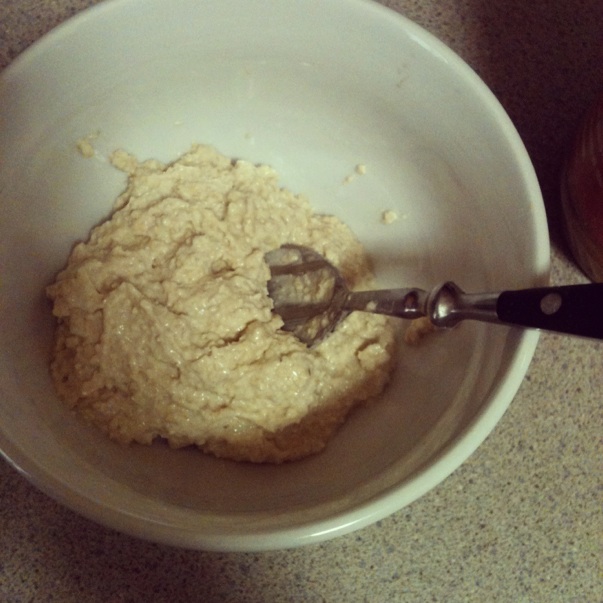Vegans, gluten-free eaters, health fanatics and the budget conscious — listen up. This post is for you.
It’s also for you if you like sourdough and do-it-yourself projects on the lazier side. Here’s the deal: you can make your own dairy-free, possibly organic, possibly gluten-free probiotic yogurt using only oats and water. Let’s put that in perspective: my favorite dairy yogurt, the Oikos organic plain Greek variety, costs NINE DOLLARS for four servings. Even if you get conventional yogurt, you’re guaranteed to be set back at least three bucks for less than a week’s servings. Making your yogurt from oats, on the other hand, costs PENNIES per serving.
And it’s really, really good. Nice and thick and creamy – with a texture halfway between cooked oatmeal and dairy yogurt. As tart as sourdough.
Here’s how you do it.
- Pour oats into a mason jar and cover with water. What kind of oats? Pretty much anything — I tried it with old-fashioned rolled oats and steel-cut oats, and both worked — steel-cut oats resulted in a better flavor, while the rolled oats had a more yogurt-like texture. You can even use raw oat groats, if you want your yogurt as unprocessed as possible. I wouldn’t recommend instant oats, but even they might work.
- Let the oats sit overnight, or until they have absorbed most of the water. The oats should be soft, like they were cooked. Then, pour the mixture into a blender and pulse until smooth.
- Pour the mixture back in the mason jar, cover with a napkin or another breathable material (like a coffee filter), and let sit in a warm place for at least 24 hours. Depending on how cold it is in your house, you may need 48 hours or more before it starts to ferment — you’ll be able to tell because it will be thicker and taste sour. Feel free to add water if it gets too thick. The longer you leave it out, the more sour it will get, as more and more super-healthy Lactobacilli will join the concoction.
- Enjoy! I like mine with a little bit of natural peanut butter drizzled on top — just like I eat my yogurt. You can keep your yogurt out and let it get more sour, or put it in the fridge with a lid on it if you like the flavor it’s reached.


I appreciate the intent of this story, but I have not seen anything as revolting as this on PRK. Sorry.
So interesting! I haven’t seen or heard of this ever before! Guess I never thought of oats fermenting. I’m tempted to try it – thanks!
I don’t see any control over what kind of micro-organisms grow. No mention of inoculating the mixture with a source of “super-healthy Lactobacilli”. There may be a wide variety of yeast, mold and other bacteria that will love this mixture. Some may not be healthy at all.
J Power – I get it! It does sound gross! But keep in mind that this process is a traditional and well-worn way to prepare oats and other grains. Making your own sourdough, for instance, relies on a similar process.
Pingback: Red Mango in Machesney Park to give away free frozen yogurt April 7 › What is gluten?